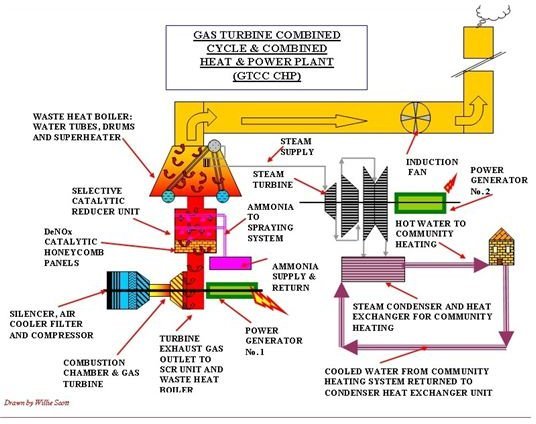Gas Turbine Combined Cycle, Co-generation Power Plants
Introduction
This is the second article on power generation and here we look at natural gas power stations, in particular gas turbine driven electrical generators. The rush for gas in the late 60’s was due to the UK Governments backing of gas fired power stations. This was because we had an abundance of high grade North Sea Gas coming ashore which was also cheap and burned more efficiently than oil and coal, emitting less CO2 in the process. The gas power stations were also a lot quicker to build and bring on line than any other type of plants. The public also played a big part in this rush for gas as a lot of people changed their central heating fuel from coal and oil to natural gas boilers. We shall examine the gas turbine operation and include a Gas Turbine Combined Cycle (GTCC) arrangement and illustrate how any remaining waste heat can be used as combined heat and power (CHP). This mix of cycles is the most efficient method of producing power from fossil fuels.
Gas Turbine Power Unit
The unit is rotated using a system like a car engine starter motor or by a more modern method of using the generator as a motor to spin the whole unit over. Once it is up to operating speed, the gas is introduced to the combustion chamber where it is fired by spark ignition. This further rotates the turbine and the air compressor on the opposite end of the shaft. This compressor draws in air through a silencer and air cooler filter unit, compressing it up to 30bar before discharging this now high pressure hot air into the combustion chamber completing the gas turbine sequence.
The main drive shaft is by now rotating at high revs, driving the power generator which produces electricity, sending it to the plant transformers before transmitting it into the national grid.
In an event of a gas supply failure there are usually back-up supplies, and also a gas – oil buffer tank which the turbine can also be run on.
Waste Heat Boiler and Steam Turbine
The exhaust gas exits the gas turbine at about 600ºC. This gas is directed to the waste heat boiler, much like a normal steam generating boiler except that instead of fuel providing the heat to the boiler water tubes, the heat is supplied by the gas turbine exhaust gas.
This resultant superheated steam used to drive a steam turbine and another power generator which also supplies electricity to the transformers and national grid. This is a very efficient system known as Gas Turbine Combined Cycle (GTCC).
Combined Heat and Power
The steam turbine is now running on steam produced from waste heat operating similar to a normal steam turbine. The low pressure steam exits from the LP stage of the steam turbine and enters the condenser, which operates under a vacuum. Cooling water circulates through it turning the saturated steam into condensate.
Normally the cooling medium used to circulate the condenser is water from a local supply, being discharged back to source. However in the case of CHP plants the cooling medium is passed through a heat exchanger giving up its heat to water circulated through the Community Heating Scheme. The cooling medium is then discharged. The addition of a CHP plant further increases the efficiency of the gas fired power station.
Exhaust gas Emissions
At present there are several methods of reducing the NOx (oxides of nitrogen emissions) mainly NO2, and SOx (oxides of Sulphur) mainly SO2 from the stack of a gas turbine generating station.
For SO2 removal
- Purchase low sulphur gas
- Remove the sulphur content from the gas before using in the turbine.
Natural gas supplies get more expensive the lower the sulphur content so the onus is on the power station to buy low sulphur gas to prevent SO2 emissions.
For NO2 removal
- Modernise the turbines so they do not produce NO2
- Fit a high or low temperature Selective Catalytic Reduction (SCR) Plant
Modernization of the gas turbines can be carried out by fitting an air and gas mixing chamber before combustion. This is known as Lean Burning Combustion and leads to fewer “hot spots” which produce the nitrogen oxide. However this is expensive and erratic at different loads, so the turbine is usually subsequently less efficient after having this fitted.
A High Temperature Selective Catalytic Reduction (SCR) plant can be employed to treat the NOx which involves spraying ammonia into the high temperature exhaust gasses. The gasses react with the NOx in the presence of a deNOx catalyst, converting the NOx into nitrogen and water vapour.
A low temperature (SCR) plant can be retrofitted out with the waste heat boiler area. This was developed because of the amount of space occupied by the high temperature model as normally this extra space was not available in the waste heat recovery complex.
Reference Webs:
2. Gas Turbines
